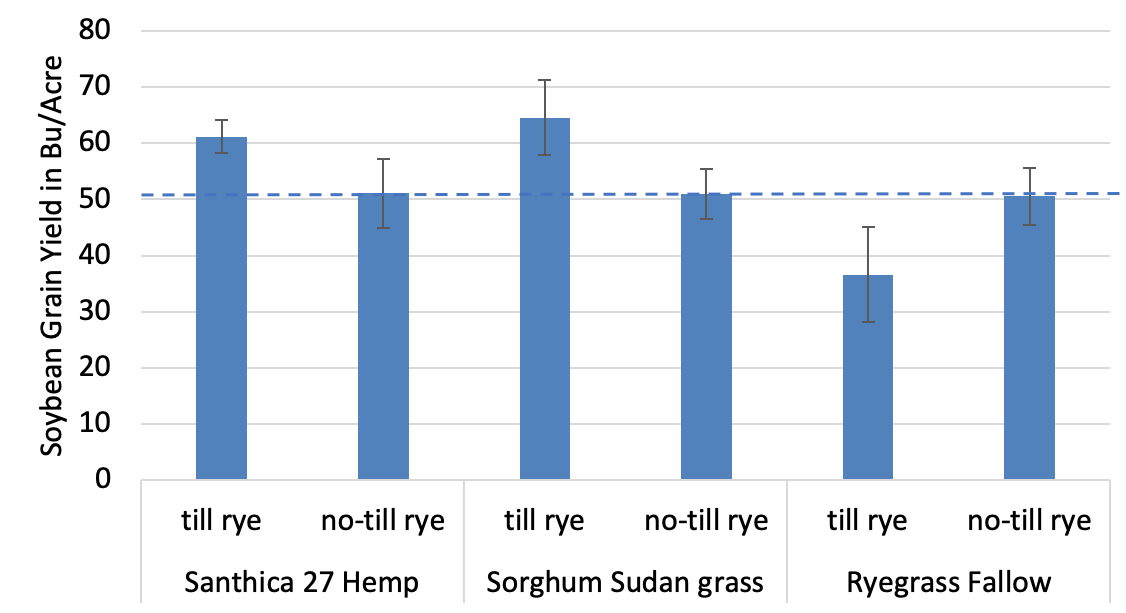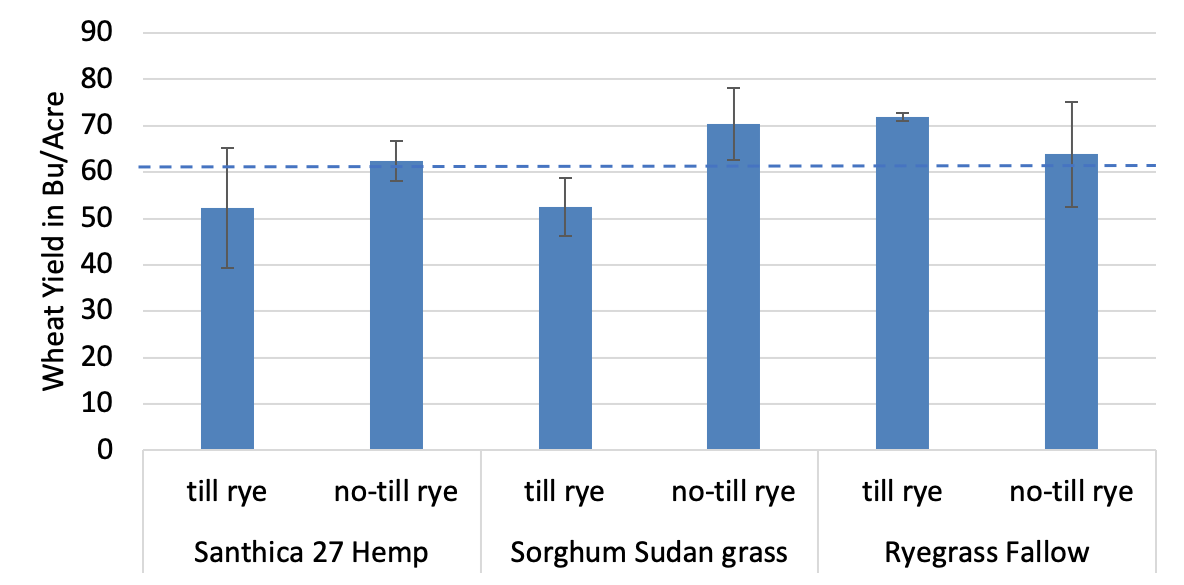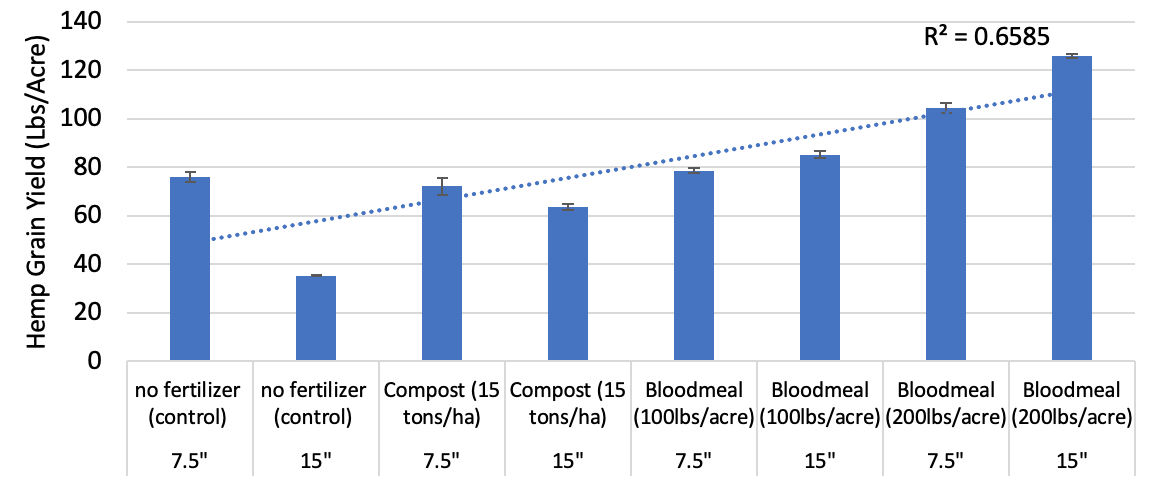In 2017, Rodale Institute initiated a four-year trial studying the effects of industrial hemp on soil health, weed suppression, and other uses. The project has just concluded its third year. More information about the trial’s scope, methodology, and results after two years can be found in “Industrial Hemp Trials: Preliminary Results,” published in 2019.
Key Updates
- Hemp mines and accumulates heavy metals in its tissues, making it a viable bioremediation crop.
- A Nutrient Management Trial was initiated in Year 3, focused on researching fertility requirements for industrial hemp. This was prompted by observations in Year 2.
- In Year 3, soybean and wheat yields were increased following hemp and sorghum Sudan grass, while weed pressure was reduced.
- Nitrogen availability appears to allow hemp to overcome weed competition at wider row spacing, while weeds appear to outcompete hemp in wider row spacings when nitrogen is limited. Higher availability of nitrogen increases hemp grain yield at wider row spacing.
Learn More About Our Industrial Hemp Trials
Project Objectives
The objectives of this project are to: 1) evaluate weed suppressing abilities of industrial hemp (Cannabis sativa) in an organic grain crop rotation, 2) reduce tillage in an organic cover-crop based rotational no-till system, 3) evaluate soil health effects of including hemp within an organic grain cropping rotation and 4) evaluate organic nutrient management practices that improve industrial hemp yield and quality. This information is expected to aid farmer decision making when incorporating hemp into an existing farming plan.
Project Overview
Industrial hemp was once considered a major cash crop for Pennsylvania and nearby states prior to its ban in the early 1940s and thus is expected to be suited to the soil and climatic conditions of the Northeast United States. Due to this ban, little to no research on industrial hemp has been conducted over the past eighty years in the U.S. resulting in knowledge gaps of basic agronomic practices. Generally, we know that hemp grows rapidly and has an extensive root system, making it a potential tool for natural weed suppression and enhancing soil health. Weed management is considered a perennial obstacle for existing organic farmers and a barrier for those considering transitioning to organic. Successful weed management in organic systems often includes intensive tillage and repeated cultivation that can degrade soil health. For this reason, Rodale Institute has been examining hemp as a potential tool for regenerative farming and weed management.
Our preliminary results from the first two years of a multiyear study indicate that hemp can suppress weeds as well as a sorghum Sudan grass (Sorghum × drummondii) smother crop. These results also indicate that fiber hemp variety in rotation can allow no-till establishment of winter cover crop without reducing the yield of subsequent crop of soybean (Glycine max) and wheat (Triticum aestivum) in the rotation.
Project Hypothesis
We predict that hemp will suppress weeds and exhaust weed seedbanks, improve soil health, reduce tillage, and improve farmer income.
Research Description
Detailed description of the ongoing variety trial, weed suppression trial, and analysis in industrial hemp can be found under Preliminary Results.
Variety Trial
The goal of this trial is to evaluate hemp varieties that are most suited to the soil and climatic conditions of Eastern Pennsylvania and determine which will be most effective to incorporate into a crop rotation to provide both agronomic and economic benefits.
Weed Suppression Trial
The weed suppression trial is evaluating the potential of hemp to act as a high-value, weed suppression cover crop in an organic rotational no-till grain cropping system and facilitate establishment of winter cover crops without tillage, while improving soil health and the yield of subsequent crops in rotation. Results will be published in extension outreach media and peer-reviewed journals to inform growers, researchers and other interest groups on best management agricultural practices that include industrial hemp in rotation.
Nutrient Management Trial
An apparent decline in germination, establishment, and overall yield observed in year two of the variety trial, attributed to likely loss of soil fertility, prompted the establishment of a nutrient management trial to determine the fertility requirements for organic hemp production. Three nitrogen (N) fertilizer treatments (compost, bloodmeal (N-P-K: 12-0-0), and compost+bloodmeal) by two different row spacings were investigated. Plant growth, plant biomass, grain yield, and nutrient concentrations in hemp grain were measured.
Prior to planting hemp, hairy vetch planted at 30 lbs. per acre in early fall of the previous year was incorporated into the soil as green manure in spring. Hairy vetch is estimated to provide 100-150 lbs. of N when tilled into the soil but this quantity of N may not always be available in sufficient quantities for the subsequent crop. Nutrient asynchrony is also not uncommon in organic systems that rely on soil biology to mineralize sources of fertility that are tied up in cover crop residue and organic matter. For that reason, additional sources of fertility may be necessary to maximize hemp yield potential.
Determining optimal plant spacing is also necessary to maximize yields. Yields may be considered total seed or fiber content or total concentration of bioactive (marketable) compounds per unit of land depending on the variety of hemp grown. Therefore, this study will not only measure soil and tissue mineral levels but will measure the concentration of bioactive compounds in plant tissue and seed oil.
Results
Variety & Weed Suppression Trials
Results in variety and weed suppression trials are consistent with the preliminary results published in 2019.
Heavy Metals
Hemp plant tissues sampled in Year 3 of the study bioaccumulated some heavy metals given that soil test results showed undetectable levels of heavy metals, suggesting that hemp can be an efficient bioremediatory crop (Table 1). We will continue to monitor heavy metal movement from soil, to tissue, to other hemp end-products to establish hemp’s efficiency as a bioremediating crop while avoiding the loss of profitable end material contaminated by heavy metals.

Yields and Weed Pressure
Hemp’s short growing period widens the window for establishing winter cover crops in late summer/early-fall, which can be difficult in Northeastern conditions when growing corn and soybeans due to late harvest. In 2017, following industrial hemp harvest, cereal rye (Secale cereale) was established in research plots using standard tillage practices or direct seeding with a no-till grain drill.
The rye was rolled-crimped and all soybean no-till planted in one pass in spring of 2018. Preliminary results indicated that ‘Santhica 27’ fiber hemp variety was as effective in suppressing weeds as sorghum Sudan grass compared to a ryegrass (Lolium multiflorum) control, and for some weeds, more effective. The 2018 average yields of soybean following hemp or sorghum Sudan grass were significantly greater in plots in which rolled down rye mulch was previously established with tillage, exceeding the 2018 national average of 52 bushels per acre (Figure 1). However, the average yields of soybeans planted in no-till rye mulch were almost equal to the national average suggesting that the economic and environmental cost of establishing the cover crop with tillage my not be justifiable or necessary if hemp is included in rotational no-till organic rotation.
Winter wheat planted following soybeans tended to have higher yields in plots in which rye cover crop was established without tillage in 2017 (Figure 2). However, this trend was only observed in plots that previously had hemp and sorghum Sudan grass. Overall, average wheat grain yields exceeded the 2019 national average of 62 bushels per acre. Additional measurements of soil and crop fertility will allow a better understanding of the effect hemp may have on subsequent crops within the crop rotation.
Figure 1. Average yields of soybeans no-till planted in rolled down cereal rye mulch previously established with or without tillage following hemp, sorghum Sudan grass or annual ryegrass control. Soybean yield planted in cereal rye mulch established with tillage was greater in all plots that previously had hemp or sorghum. The opposite was the case with regard to the control plots. The dashed line illustrates the 2018 national average winter wheat yield (52 bushels/acre).


While interesting trends were observed in the preliminary work, it is necessary to validate these results by repeating the study with greater replication to confirm statistical differences.
Nutrient Management Trial
In the first year of the Nutrient Management Trial (2018) we had a control treatment (no soil amendments/fertilizer added), a compost treatment (compost produced on site, cured one year, and applied at 15 tons/acre), a moderate (100lbs/acre) and a high (200lbs/acre) rate of bloodmeal (NPK: 12-0-0) application prior to planting. All amendments were applied immediately before planting, incorporated with a Perfecta harrow and packed prior to planting.
Preliminary results revealed a positive linear relationship (r2 = 0.66) between N application rates and hemp grain yield with the control plots (no fertilizer treatment) showing the lowest grain yield. As expected, hemp grain yield increased with increasing N application rate, with the highest rate of bloodmeal (200lbs/acre) producing the greatest grain yield followed by lowest rate of blood meal (100lbs/acre) and compost treatment (Figure 3).
The trial also included two row spacing treatments, 7.5” and 15” rows. When fertility was limited (control and compost only), the wider spacing had a negative effect on hemp grain yield which was likely due to higher weed pressure. In the bloodmeal treatments where N was less limiting than the other treatments, hemp appeared to have competed better with weeds in both row spacing treatments, but the wider spacing tended to perform better than the narrower spacing (Figure 3). According to Rosenberg et al. (Oregon State University Extension, 2019; Soil, Seedbed Preparation and Seeding for Hemp), wider spacing allows plants to branch out and produce maximum flowering density, which can translate into higher yields, but there is a need to determine the optimum row spacing that cannot limit the maximum potential plant density and maximum potential yield.
The linear relationship of this data suggests that the maximum grain yield may not have been obtained. For this reason, further exploration with increased N application rates with better weed management should be conducted. We propose including a leguminous cover crop treatment, additional bloodmeal application rates and measure nitrogen leaching potential at these fertilizer rates. We would also like to include a practice used by many farmers where compost is initially applied and additional fertility needs are supplemented with a fertilizer, like bloodmeal. In addition, we will calculate N budgets by measuring the total N in plant tissue and grain, determine available N produced by the N-fixing cover crop, analyze baseline, mid-season, and post-season soil samples for potentially mineralizable N, and test potential N leached into the ground water using suction cup lysimeters.

Conclusions
- Hemp mines and accumulates heavy metals in its tissues, making it a viable bioremediation crop.
- Soybean and wheat yields were increased following fiber hemp, while weed pressure was reduced.
- Nitrogen availability allows hemp to outcompete weeds and increase grain yield at wider row spacing, while weed species outcompete hemp at wider row spacings when nitrogen is limited.
Preliminary Project Evaluation Results
Since the launch of the Rodale Institute Industrial Hemp research program in 2017, public interest in our work is growing rapidly, with 2019 webpage visits recording over 9 times the visits in 2018. In addition to attending conferences and meetings, Rodale Institute staff consult with farmers regularly across the Northeast and entire United States on growing industrial hemp in a regenerative way to determine how hemp can benefit farmers while mitigating environmental impacts.
Implications
Our research and outreach will have a positive impact on the rapidly growing hemp market due to the lack of information available for farmers on best agronomic practices to produce high quality hemp products in the Northeastern United States. There is a great need to better understand standard practices, like fertility requirements of hemp to improve the success of PA hemp farmers.
The additional attention and funding received this year from both Dr. Bronner’s and CV Sciences allowed us to transition the hemp project management roles to include a “Hemp Specialist” position with 100% of their effort dedicated to managing and growing the Institute’s hemp research.
Future Direction
- To increase farmer income, learn more about seed and dual- purpose varieties and determine if they can fit into a grain rotation as a weed smother crop as well as fiber varieties. Additionally, investigate cost-effect technologies of successfully harvesting fiber, seed, and dual-purpose varieties.
- Expand research and cultivation to different soils and states to ensure these rotations can translate across the county.
- Continue the Nutrient Management Trials, both in industrial and CBD hemp to better understand fertility requirements in regenerative organic management systems to improve yield and quality and ultimately increase farmer income.
Funding for Rodale Institute’s Industrial Hemp Trial and support for research provided by Dr. Bronner’s, CV Sciences, and Natural Care PA. Special thanks to the PA Department of Agriculture for funding the Nutrient Management Trial.
